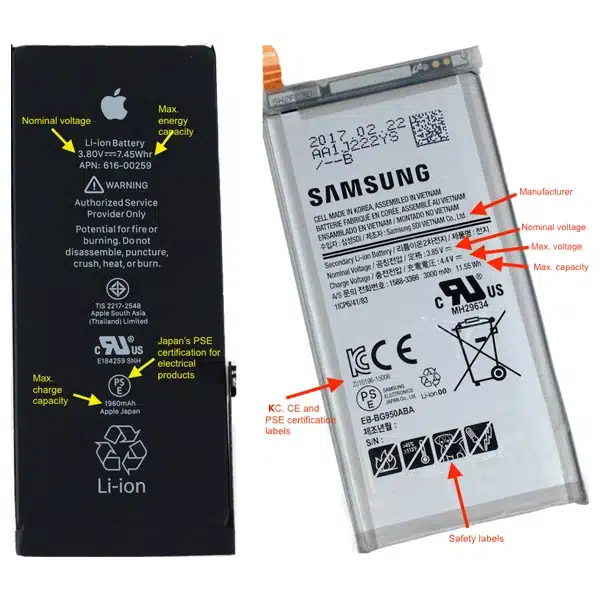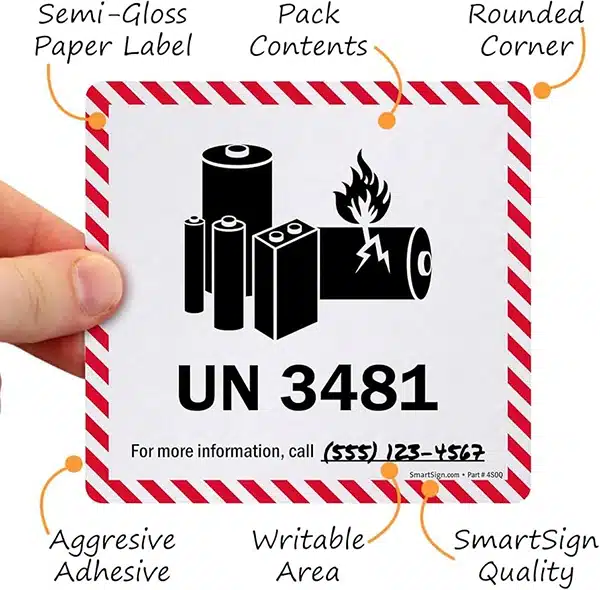Labels are not only an important tool for battery identification, but also a core part of ensuring safe operation, compliant transportation, and meeting regulatory requirements. They can help you and transport personnel identify battery types, potential hazards, and necessary safety measures. This article will deeply analyze the components of lithium battery labels, relevant regulatory requirements, and provide practical suggestions for labeling compliance.
Table of Contents
ToggleComponents of lithium ion battery label
There is a lot of key information on the lithium battery label, providing the battery type, safe use, and compliance with relevant regulations. The following are some important contents commonly found on the label:
Product information

- Voltage: The voltage of a battery (such as 3.7V or 7.4V) indicates the potential difference of the battery, which determines the strength of the battery’s energy output. The motor or electric machine of your device must match the battery voltage.
- Capacity: Measured in mAh or Ah, capacity is the amount of energy a battery can store. For example, a 2Ah battery can deliver 2,000 milliamps of current in one hour. The larger the capacity, the longer the battery lasts.
- Model: It is the battery’s “ID card” that helps quickly identify the battery type and ensures it is compatible with the device.
- Production date: Indicates the production date of the battery. Batteries have self-discharge, and battery performance will gradually decline even if they are not used. This helps to assess the remaining life of the battery.
- Size: refers to the length, width and thickness of the battery. The battery size must perfectly match the device’s battery compartment to avoid installation problems.
- Weight: It will directly affect the use of the device and is also related to transportation requirements. DHL stipulates that the weight of each box of batteries cannot exceed 10Kg.
- Charging voltage: helps you choose the right charger to avoid safety hazards such as overcharging or short circuit.
- Production batch: used for tracking and management. If there is a quality problem with a batch of batteries, this number can help consumers and manufacturers trace and recall.
Safety information
- Flammable materials: This symbol looks like a flame and the battery can catch fire if not handled properly. Lithium batteries are sensitive to heat and physical damage, so this warning is very important.
- Do not short-circuit: Usually represented by a crossed-out battery and sparks, this means do not short-circuit the positive and negative terminals. Short-circuiting can cause the battery to overheat, which may cause a fire or explosion.
- Do not disassemble: The battery cannot be disassembled, and there is a line running through the middle. It reminds you that it is dangerous to privately open the battery. Lithium batteries contain chemicals inside that may cause harm if exposed.
- Recycling: The symbol of three arrows chasing each other, forming a triangle. It indicates that batteries should be properly recycled. Otherwise, it may cause harm to land resources.
These warning messages are intended to remind you and the transport personnel to adopt correct operating methods to prevent accidents.
Certification information
The following certifications contain specific test items to help you understand the importance and purpose of the certification.
- CE mark (EU market): covers the battery’s electrical safety, thermal stability, and electromagnetic compatibility test items. CE certification follows the EN 62133 standard, which mainly tests the battery’s safety performance, including short-circuit protection, temperature cycling, overcharge, and discharge tests (Source: EU EN 62133)
- The UL Mark (North American Market) is a required certification for entering the US and Canadian markets, ensuring the electrical safety and fire protection of the battery during use. This certification verifies the safety of lithium batteries in extreme conditions such as high temperature, overcharge, short circuit, etc., ensuring that your device will not malfunction due to battery problems.
- RoHS (environmental protection certification) ensures that lithium batteries comply with environmental regulations in the European market and strictly restrict harmful substances (lead, mercury, cadmium, etc.). This certification ensures that lithium batteries will not cause environmental pollution during production and use, and strictly regulates the content of other harmful substances.
- UN38.3 (Transport Safety Certification): It is a global safety standard for lithium battery transportation, applicable to air, sea and land transportation. This certification covers safety test items such as: altitude simulation, temperature test, vibration and shock test and external short circuit test. Detailed test standards can be obtained on the UN official website.
- CCC Compulsory Certification (China Market) is a mandatory safety certification for electronic products in the Chinese market, ensuring that lithium batteries meet China’s safety standards. This certification covers the battery’s electrical safety, material compliance, and environmental adaptability, ensuring safe electricity use.
Shipping information
UN Number: This is a four-digit number used to identify a hazardous substance.
- UN3480: Applicable to lithium-ion batteries (PI965) transported separately. Such batteries must strictly comply with safety regulations during transportation to avoid accidents caused by short circuits, overheating, etc.
- UN3481: Applicable for installation in equipment (PI967). Compared with UN3480, the transportation requirements of UN3481 are more relaxed, but strict safety measures are still required.

Handling and packaging labels:
During the transportation of lithium batteries, handling and packaging labels are a prerequisite for safe transportation and handling. Common labels and instructions are as follows:
- Handling instructions: such as the “this side up” sign to remind transporters to properly place the battery. There are also “handle with care” or “do not load on passenger aircraft”, which are designed to prevent accidents during transportation.
- Package label: Usually with a red warning slash frame and battery logo, indicating that the package contains lithium batteries and requires special handling. Let the transporter know in advance and operate safely.
Detailed description of the transport requirements for UN3481:
- Label content: When transporting batteries, the packaging must be affixed with a UN3481 label indicating the battery type and its transportation method. In addition, the packaging must also be attached with 9 types of dangerous goods signs to ensure that transport personnel can quickly identify and properly handle them.
- Packaging standards: Lithium batteries must be packed in materials that comply with United Nations (UN) standards. The outer box should be clean and tough to prevent damage to the battery during transportation. The packaging materials must be able to prevent short circuits, leakage or other potential hazards.
Lithium battery shipping label regulations and requirements
International regulations and standards:
- 49 CFR (US Transportation Standard): It is the US regulation on the transportation of dangerous goods, formulated by the US Department of Transportation (DOT). It stipulates how to safely transport lithium batteries, and provides detailed guidance on packaging, labeling, documentation requirements, etc. Complying with the 49 CFR standard can ensure smooth transportation within the United States.
- IATA DGR (Dangerous Goods Regulations): specifies the air transport requirements for lithium batteries, covering three aspects: packaging, labeling and documentation requirements. The IATA DGR standard specifies how lithium batteries must be packaged, which labels need to be attached, and the requirements for filling out transport documents to ensure the safe air transport of lithium batteries. All airlines and freight companies must follow the IATA DGR regulations.
- IMDG (International Maritime Dangerous Goods) Code: is the global standard for the transportation of dangerous goods by sea, which stipulates the packaging, labeling and transportation requirements of dangerous goods. For lithium batteries, IMDG Code requires that the packaging must comply with UN standards to ensure safety during transportation and prevent safety accidents. IMDG Code is a key standard that cannot be ignored in international shipping.
- TDG (Transportation of Dangerous Goods) is Canada’s regulation on the transportation of dangerous goods, requiring that all dangerous goods packaging must be clearly labeled and marked with their categories. For example, lithium-ion batteries are classified as class 9 hazmat. According to TDG standards, when transporting lithium batteries, strict packaging, labeling and transportation requirements must be followed to ensure safety during transportation.
How to ensure compliance with the lithium battery dangerous goods label
- Clear and legible: The text and icons on the label must be clear and easy to identify. Blurred or incomplete labels cannot be used. You can quickly read and understand all key information, such as battery model, voltage, capacity, and safety warning symbols. Ensure that the text, symbols, and graphic designs have sufficient contrast and adapt to various environmental conditions to avoid loss of information.
- Durability: Lithium battery labels should be made of materials that are resistant to high temperatures, water and abrasion. Labels should be able to withstand friction during transportation and changes in the external environment (such as temperature and humidity) to avoid information loss or misuse due to label damage.
- Accuracy: All information on the label must be accurate, complete and up-to-date. Ensure that the marked battery model, voltage, capacity, production date, etc. are consistent with the actual battery parameters. Incorrect label content may cause safety accidents. Therefore, manufacturers should regularly review and update label content to ensure accuracy.
- Tips for checking supplier labels: You can use the above description to check whether the labels meet the standards: the inspection items include UN number and transport mark, safety symbols and warning information, and certification marks.
Summarize
In short, labels are vital information for lithium battery manufacturers, transporters and users. They not only contain basic information about the battery, but also key information such as safety warnings, certification marks and transportation requirements. Understanding the content and meaning of these labels can help ensure the safe use and compliant transportation of batteries and avoid potential risks and misuse.
When choosing lithium batteries, always check the design and compliance of the label to ensure that the product meets international standards to maximize safety and performance.
For more detailed information on lithium battery label design and compliance, please visit Hongyitai homepage to get more high-quality lithium battery solutions and labeling services.
FAQs
Not all lithium battery labels are created equal. The content and format of the label may vary based on several factors:
Battery type: Different types of lithium batteries (e.g. lithium-ion, lithium-polymer) may require different label information. Lithium-polymer batteries generally require additional safety warnings.
Intended use: The purpose of the battery will also affect the content of the label. Cell phone battery labels often contain more detailed instructions for use, while batteries used in power tools may have different labeling requirements.
Regulatory requirements: Label content will vary according to regulatory requirements in different regions. There may be differences in lithium battery labels in Europe and the United States because they are subject to different regulations and certification standards.
Manufacturer requirements: Different manufacturers may use different label formats according to their own designs and standards. In addition to the core information of the logo, its display method and additional details may vary.
The lithium battery label 3481 refers to lithium batteries contained in or packed with equipment. The transportation of these batteries is subject to IATA and IMDG regulations, ensuring that the batteries are transported safely in accordance with appropriate measures.
According to regulations, lithium battery labels do not necessarily have to be printed in color, but the key information on the label must be clearly readable. Generally, black text and symbols with a high-contrast background can meet basic compliance requirements. Color printing is often used for emergency warnings and transportation instructions.
If the label is lost or damaged during transport or use, it must be replaced as soon as possible to ensure compliance with all regulatory requirements. It is recommended that you contact the battery manufacturer immediately to obtain a new label and ensure that the label is re-applied in accordance with local and international regulations.
